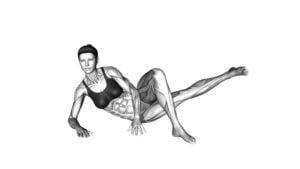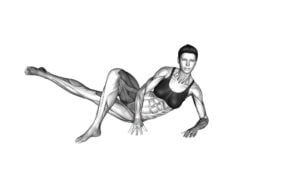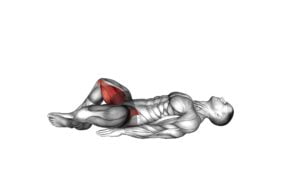Lying Hip Adduction (female) – Video Exercise Guide & Tips

Are you looking to strengthen your hip muscles?
Watch This Exercise Video
In this article, we'll guide you through Lying Hip Adduction exercises specifically designed for females.
By incorporating this exercise into your routine, you can improve hip stability and prevent injuries.
With our video guide and tips, you'll learn the proper form and technique to maximize the benefits of Lying Hip Adduction.
Say goodbye to common mistakes and hello to a stronger, more balanced lower body.
Let's get started!
Key Takeaways
- Lying hip adduction targets the adductor muscles to strengthen and tone the inner thighs.
- It helps prevent muscle imbalances between the outer and inner thigh muscles.
- Lying hip adduction improves hip stability and alignment.
- There are variations and alternatives to target specific areas of the inner thigh muscles and enhance overall lower body strength.
Benefits of Lying Hip Adduction
The lying hip adduction exercise offers numerous benefits for women looking to strengthen their inner thigh muscles. This exercise primarily targets the adductor muscles, which are responsible for bringing the legs towards the midline of the body. By performing this exercise, you can improve the strength and tone of your inner thighs.
One of the main benefits of the lying hip adduction exercise is that it helps to prevent muscle imbalances. Many women tend to have stronger outer thigh muscles compared to their inner thighs, which can lead to instability and potential injuries. By incorporating the lying hip adduction exercise into your routine, you can ensure that your inner thigh muscles are sufficiently strengthened, creating a more balanced and stable lower body.
Another benefit of this exercise is that it can help to improve overall hip stability. The adductor muscles play a crucial role in maintaining proper alignment and stability of the hips. By strengthening these muscles through the lying hip adduction exercise, you can enhance your hip stability, which is important for various activities such as walking, running, and jumping.
There are several variations of the lying hip adduction exercise that you can try to target different areas of the inner thigh muscles. Some variations include using resistance bands, performing the exercise on an incline bench, or using a stability ball. These variations can add variety to your workout routine and target specific areas of the inner thigh muscles for optimal results.
Equipment Needed for Lying Hip Adduction
To perform the lying hip adduction exercise, you'll need a resistance machine that specifically targets the adductor muscles. This machine typically consists of a padded seat with adjustable resistance levels, as well as pads or straps to secure your legs.
If you don't have access to this equipment, you can also try alternative exercises such as side-lying leg lifts or clamshells to target the same muscle group.
Required Equipment for Adduction
To perform the lying hip adduction exercise, you'll need a resistance band or cable machine. These are the two main equipment options for this exercise.
A resistance band is a versatile and affordable option that allows you to adjust the resistance level according to your fitness level. On the other hand, a cable machine provides a consistent resistance throughout the movement, making it a great choice for targeting the muscles effectively.
Both options offer benefits of adduction, which include strengthening the inner thigh muscles, improving hip stability, and enhancing overall lower body strength.
It's important to choose the equipment that suits your preferences and fitness goals. Remember to follow proper form and start with a weight or resistance level that challenges you but allows you to maintain proper technique.
Alternatives to Hip Adduction
For an alternative to hip adduction using the equipment needed for lying hip adduction, you can try other exercises that target the same muscles.
One alternative exercise that you can do is using resistance bands. You can place the resistance band around your thighs and perform lateral walks, stepping sideways while maintaining tension on the band. This exercise engages the hip adductor muscles and helps improve their strength and stability.
Another alternative is using a cable machine. You can attach an ankle strap to the cable machine and perform standing hip adductions by pulling your leg across your body against the resistance of the cable. This exercise also targets the hip adductor muscles and can be adjusted to different resistance levels to challenge your muscles further.
Remember to always consult a professional trainer before attempting new exercises and to use proper form to prevent injury.
Proper Form and Technique for Lying Hip Adduction
You can achieve proper form and technique for lying hip adduction by following these guidelines.
Lying hip adduction is a great exercise that targets the inner thigh muscles, helping to strengthen and tone them. It also works the hip abductor muscles, which are responsible for moving the leg away from the midline of the body. By incorporating lying hip adduction into your workout routine, you can improve your lower body strength and stability.
To perform lying hip adduction correctly, start by lying on your side with your bottom leg straight and your top leg bent at a 90-degree angle. Place a resistance band around your ankles and engage your core muscles. From there, slowly lift your bottom leg towards the ceiling, keeping it straight and in line with your body. Pause for a moment at the top and then lower your leg back down to the starting position. Repeat for the desired number of repetitions.
Now that you understand the proper form and technique for lying hip adduction, let's discuss some common mistakes to avoid. Transitioning into the next section, it's important to be aware of these errors to maximize the effectiveness of your workout and minimize the risk of injury.
Common Mistakes to Avoid in Lying Hip Adduction
Now, let's delve into the common mistakes to avoid when performing lying hip adduction to ensure optimal results and minimize the risk of injury.
One of the most common mistakes is using improper form. It's important to maintain proper alignment throughout the exercise by keeping your hips and shoulders squared and your spine in a neutral position. Avoid arching your back or allowing your hips to roll forward or backward.
Another mistake to watch out for is using too much weight. Using excessive resistance can compromise your form and increase the risk of injury. Start with a lighter weight and gradually increase as you become comfortable with the movement.
Lastly, rushing through the exercise is another mistake to avoid. Take your time and focus on the muscle contraction during each repetition.
By performing the lying hip adduction exercise with proper form and technique, you'll maximize its benefits and minimize the risk of injury.
Now, let's move on to exploring the variations and progressions of lying hip adduction.
Variations and Progressions of Lying Hip Adduction
Now that you have a solid foundation in lying hip adduction, it's time to explore the variations and progressions of this exercise. By incorporating advanced progressions for adduction, you can continue challenging your muscles and making progress in your strength training.
Additionally, alternative exercises for adduction can provide variety and target different muscle groups to keep your workouts interesting and effective.
Advanced Progressions for Adduction
How can you progress the lying hip adduction exercise for advanced variations and progressions?
When you have mastered the basic lying hip adduction exercise, there are advanced techniques you can incorporate to further challenge your muscles.
One option is to increase the resistance by using a resistance band or ankle weights. This will require your muscles to work harder and will help to further strengthen and tone your hip adductors.
Another advanced variation is to perform the exercise on an unstable surface, such as a stability ball or a Bosu ball. This won't only target your hip adductors but also engage your core and improve your balance.
Additionally, you can try performing the exercise at a slower pace or increasing the number of repetitions and sets to increase the intensity.
Alternative Exercises for Adduction
To further challenge your muscles and continue progressing in your hip adduction exercises, you can explore alternative exercises that provide variations and progressions of the lying hip adduction.
These alternative exercises not only help to target your adductor muscles in different ways but also add excitement and variety to your workout routine.
One popular alternative exercise is the standing cable hip adduction. This exercise involves attaching a cable to your ankle and standing sideways with the cable machine. You then bring your leg across your body, using the cable resistance to work your adductor muscles.
Another modification is the seated hip adduction machine. This machine allows you to sit upright and press your thighs together against a resistance pad, effectively targeting your adductors.
Adding these alternative exercises to your routine won't only help you strengthen and tone your adductor muscles but also provide a fun and challenging workout experience.
Tips for Incorporating Lying Hip Adduction Into Your Workout Routine
Start by incorporating lying hip adduction into your workout routine with proper form and an appropriate weight. Lying hip adduction is a great exercise that targets the muscles of the inner thighs, helping to strengthen and tone them. It can be beneficial for anyone looking to improve their lower body strength and stability.
When performing lying hip adduction, it's important to maintain proper form to avoid any potential risks or injuries. Make sure to keep your core engaged and your back flat against the floor throughout the movement. Start with a weight that challenges you, but allows you to maintain good form. As you become more comfortable with the exercise, you can gradually increase the weight to continue challenging your muscles.
Modifying lying hip adduction for different fitness levels is simple. If you're a beginner, you can start by using lighter weights or even just your body weight. Focus on perfecting your form and gradually increase the intensity as you get stronger. For more advanced individuals, you can increase the weight or try using resistance bands to add an extra challenge.
Incorporating lying hip adduction into your workout routine can help you achieve your fitness goals and improve your overall lower body strength. Just remember to always listen to your body and consult with a professional if you have any concerns or questions.
Frequently Asked Questions
How Many Sets and Reps Should I Do for Lying Hip Adduction?
To strengthen your hips after childbirth, incorporating postpartum exercises like lying hip adduction can be beneficial. When determining sets and reps, it's important to start with a comfortable level of intensity and gradually increase over time.
A good starting point could be 2-3 sets of 10-12 repetitions per session. However, it's always best to consult with a healthcare professional or a certified trainer who can provide personalized guidance based on your specific needs and goals.
Can Lying Hip Adduction Help With Postpartum Recovery?
Lying hip adduction can be beneficial for postpartum recovery by targeting the pelvic floor muscles. Pelvic floor exercises after childbirth are important to strengthen and support the pelvic region. Hip adduction exercises specifically engage the inner thigh muscles, which can help improve stability and alignment in the pelvis.
This exercise can also aid in restoring core strength and reducing the risk of urinary incontinence. Incorporating lying hip adduction into your postpartum exercise routine may contribute to a faster recovery and improved overall wellness.
Is Lying Hip Adduction Safe for Individuals With Knee Injuries?
Lying hip adduction can be a helpful exercise for strengthening the inner thigh muscles. However, it may not be safe for individuals with knee injuries. If you have a knee injury, it's important to prioritize knee injury prevention and avoid exercises that may aggravate the condition.
There are alternative exercises that can target the same muscle group without putting strain on the knees. It's best to consult with a healthcare professional or a physical therapist for personalized recommendations.
How Often Should I Incorporate Lying Hip Adduction Into My Workout Routine?
To incorporate lying hip adduction into your workout routine, start by performing the exercise 2-3 times per week.
As a beginner, modify the movement by using lighter resistance or performing fewer repetitions.
Remember to keep your core engaged and maintain proper form throughout the exercise.
Common mistakes to avoid include using momentum to lift the leg and allowing the hips to rotate or lift off the ground.
Consistency and proper technique will help you get the most out of this exercise.
Can Lying Hip Adduction Help Improve My Balance and Stability?
Lying hip adduction can indeed help improve your balance and stability. By targeting the muscles in your inner thighs, this exercise strengthens your core and enhances stability.
The benefits of lying hip adduction extend beyond just toning your legs. It also engages your abdominal muscles, which in turn improves your overall balance.
Adding this exercise to your routine can have a positive impact on your core strength and overall stability.
Conclusion
Incorporating lying hip adduction into your workout routine can provide numerous benefits for women. This exercise helps strengthen the hip muscles, improve stability, and enhance overall lower body strength.
By following proper form and technique, avoiding common mistakes, and exploring variations and progressions, you can maximize the effectiveness of this exercise.
So, add lying hip adduction to your fitness routine and enjoy the benefits it brings to your lower body strength and stability.

Author
Years ago, the spark of my life’s passion ignited in my mind the moment I stepped into the local gym for the first time. The inaugural bead of perspiration, the initial endeavor, the very first surge of endorphins, and a sense of pride that washed over me post-workout marked the beginning of my deep-seated interest in strength sports, fitness, and sports nutrition. This very curiosity blossomed rapidly into a profound fascination, propelling me to earn a Master’s degree in Physical Education from the Academy of Physical Education in Krakow, followed by a Sports Manager diploma from the Jagiellonian University. My journey of growth led me to gain more specialized qualifications, such as being a certified personal trainer with a focus on sports dietetics, a lifeguard, and an instructor for wellness and corrective gymnastics. Theoretical knowledge paired seamlessly with practical experience, reinforcing my belief that the transformation of individuals under my guidance was also a reflection of my personal growth. This belief holds true even today. Each day, I strive to push the boundaries and explore new realms. These realms gently elevate me to greater heights. The unique combination of passion for my field and the continuous quest for growth fuels my drive to break new ground.



